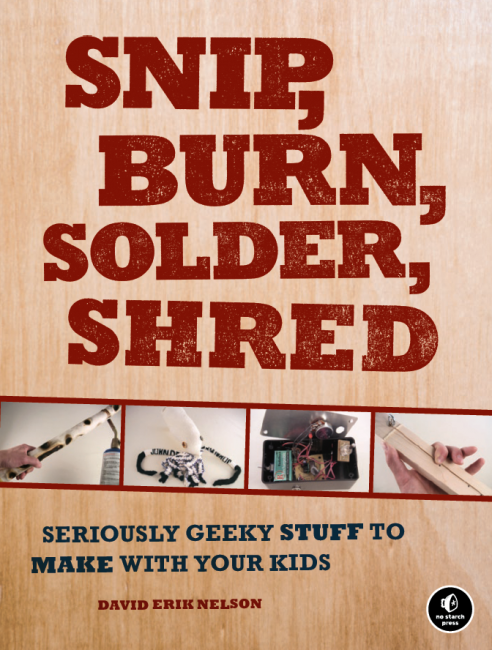’nuff said; frikkin RAD!

millennium falcon part list and instructions
(I love that he’s included a LEGO Digital Designer file for this build.)
(via Man Made DIY)
’nuff said; frikkin RAD!

millennium falcon part list and instructions
(I love that he’s included a LEGO Digital Designer file for this build.)
(via Man Made DIY)
. . . and get the ebooks (in PDF, mobi, and ePub formats) for *FREE*!

Order Snip, Burn, Solder, Shred directly from the publisher, use the coupon code SHRED, and save 35% (i.e., pay one fat quarter *less* than you would ordering from Amazon). And Amazon would nick you another $10 for the Kindle version, where-as No Starch tosses it in for free (along with a really slick PDF–pretty as hell on an iPad, if you’re an iPad person).
Buy a paper copy of my book for your cousin and keep the PDF for yourself–or, Hell, buy a dead-tree version for your cousin, give him the digital bundle on a thumb drive, and *keep a copy of the ebooks for yourself, just like Jake Sparrow would.* It’s fine by us! See if Amazon will give you *that* deal.
It’s about *sharing* the love is what we’re saying, and ’tis the season for that.
 If you have a little soldering experience–including building any of the electonics projects in Snip, Burn, Solder, Shred–then you’re ready for T. Escobedo’s “Circuit Snippets.” This document includes several dozen sound circuits (largely guitar effects, although they work with any sort of instrument you can plug into an amp), which range from the relatively common (e.g., distortion pedals, phasers, envelope followers, pre-amps, auto-wahs) to uncategorizable strangenesses. In terms of quality, many of these sound as good as mass-market stompboxes at one-tenth the price.
If you have a little soldering experience–including building any of the electonics projects in Snip, Burn, Solder, Shred–then you’re ready for T. Escobedo’s “Circuit Snippets.” This document includes several dozen sound circuits (largely guitar effects, although they work with any sort of instrument you can plug into an amp), which range from the relatively common (e.g., distortion pedals, phasers, envelope followers, pre-amps, auto-wahs) to uncategorizable strangenesses. In terms of quality, many of these sound as good as mass-market stompboxes at one-tenth the price.
(The Synthstick entry has a bit more about Escobedo’s FolkUrban website, but the short story is that it was really cool, had lots of great designs for different instruments, and disappeared with GeoCities in October 2009. I saved PDFs of “Circuit Snippets” and the Synthstick, but many other Escobedo fans have done a much better job of archiving than I did, scooping up all of the audio samples, too. The “Circuit Snippets” mirror at Guitar HQ UK is one such faithful recreation of the old GeoCities page.)
“Circuit Snippets” by T. Escobedo
 For years, Tim Escobedo maintained the excellent FolkUrban website, which featured a wide array of instruments–both traditional and electronic–cunningly made from cheap, common supplies (lots of PVC and tupperware, grocery sacks, etc.) His projects were a huge influence, and served as invaluable templates to my tinkering; the synthstick was the first synth I ever built, and its VCO (the core noise-making circuit) found its way into many of my projects, as well as those built by my students (sharp eyes will see something very similar nestled at the heart of the Cigar Box Synth, Project 17).
For years, Tim Escobedo maintained the excellent FolkUrban website, which featured a wide array of instruments–both traditional and electronic–cunningly made from cheap, common supplies (lots of PVC and tupperware, grocery sacks, etc.) His projects were a huge influence, and served as invaluable templates to my tinkering; the synthstick was the first synth I ever built, and its VCO (the core noise-making circuit) found its way into many of my projects, as well as those built by my students (sharp eyes will see something very similar nestled at the heart of the Cigar Box Synth, Project 17).
GeoCities evaporated in October 2009, and Escobedo’s entire site with it. I archived the Synthstick and his collection of Circuit Snippets as PDFs, but these don’t include any of the audio examples. Happily, I’ve discovered that many other tinkerers loved Escobedo’s site as much as I did, and archived various chunks; Googling for “T. Escobedo” is a good place to start.
“The Synthstick” by T. Escobedo
 For years, Steven L. Sachs maintained a great page on didgeridoos. It largely concerned making PVC didges like the Electro-Didgeridoo (Project 11 in the book), but also offered info on modifying lower-cost store-bought bamboo and teak didges into instruments that, sonically, could often pass for their genuine (and expensive) eucalyptus cousins. When GeoCities folded in October 2009, it took Steven’s site with it. I’ve archived a PDF of his page, and humbly offer it here:
For years, Steven L. Sachs maintained a great page on didgeridoos. It largely concerned making PVC didges like the Electro-Didgeridoo (Project 11 in the book), but also offered info on modifying lower-cost store-bought bamboo and teak didges into instruments that, sonically, could often pass for their genuine (and expensive) eucalyptus cousins. When GeoCities folded in October 2009, it took Steven’s site with it. I’ve archived a PDF of his page, and humbly offer it here:
“Making PVC Didgeridoos” by Steven L. Sachs

If you have a decently stocked tool room, then this is a great intro-level woodworking project with gift-quality results. FYI, even if you don’t own a Dremel or drill press (I don’t, the charger for mine died this past weekend), you can totally get by with just a hand-held power drill for this project, you’ll just need to be a little more attentive (and will likely get a slightly soarer arm–a drill is a lot heavier than a Dremel).
Project: Wooden Salt Cellar @Craftzine.com blog
Oh, and one safety tip: This project describes using some fallen wood from a fruit tree. If that’s not an option for you and you’re instead going to buy lumber, make sure and tell the salesperson what you’re up to: construction wood is very often sprayed with chemicals in order to prevent pests from chewing it up (arsenic used to be common, although I think that’s been outlawed in many States). A lumber yard will *always* be able to steer you toward food-safe wood.
collectSPACE – news – “LEGO figures flying on NASA Jupiter probe”

If you’re wondering why they look so classical and funky, space.com explains:
In other words, those are the most over-engineered LEGO minifigs you’ll ever see, kids.
(photo credit)
I met a scads of great folks at Maker Faire Detroit this year, including William Wardrop, who crafts *fantastically* rad cardboard model steampunk vehicles from legal-pad backing boards (!!!)
Aircraft – Steam Noir

*Lots* of great models at his site; very worth poking around.
The 8 Most Wildly Irresponsible Vintage Toys | Cracked.com
I’m kind of divided here. On the one hand, in the clear light of 21st C day, these toys are totally *insane.* On the other, I was born in the mid-1970s and grew up in the suburbs outside Detroit, and I *remember* kids just a little older than me casting their own lead soldiers, for example. As middle schoolers we’d buy calcium carbide (used to power the Austin Magic Pistol in the embedded video) from the hardware store and make acetylene lamps from baby food jars and fire-balls with party balloons and soda bottles (I haven’t the foggiest what the approved use of calcium carbide was in the 1980s; it isn’t like I grew up in coal country).
The final bit of nostalgia: The Gilbert U-238 Atomic Energy Laboratory.

Did I own one of these? Sweet Monkey Jesus *NO*! But I *did* take to rock collecting in early elementary, which lead to my mom giving me her old rock collections–mostly bought as little pre-boxed souvenir sets while on family vacations (she grew up in the West). Right in the middle of these was a little off-white chunk of stone; it could have been an especially pale chip of concrete, except for it’s red, all-caps label: URANIUM
No lie. Welcome to the Atomic Age in America.
I haven’t the foggiest where that rock set wound up. Part of my *really* wants to know, but the rest just hopes it isn’t kicking around my basement office where I sit typing most days.
We’ve entered the season of class projects, Science Fairs, cooped-up weekends, and dreary afternoons. Folks seem to think Snip, Burn, Solder, Shred can help with that (check out the Amazon reviews!), and I’m inclined to agree.
Amazon clearly has their every-day deal (usually 30-something percent off; it actually changes from day to day, and I have no idea why), and also sells the Kindle version for a flat $9.99. Here’s the New Deal: Order Snip, Burn, Solder, Shred directly from the publisher using coupon code SHRED and they’ll knock 35% off the cover price of either the print edition or the ebook pack (which includes DRM-free PDF, ePub, and Kindle-compatible versions). *Added Bonus*: When you buy the print edition, No Starch includes the ebook bundle for *free.* I’m not a *huge* ebook fan for something as picture intensive as a DIY book, but these ebooks are really slick: The PDF version is basically the source-file used to print the paper copies, and reads *excellently* on an iPad. The .mobi and .epub ebooks look sharp on Kindles (and their ilk), and have all of the cross-references formatted as links: Every place I say something like “As you’ll recall from Project #22,” or whatever, you can click on the “Project #22” and go straight to that section without fumbling or undue distraction. It might not seem like much, but it’s *really* handy when you’re midway through soldering and forget which leg of an LED is negative, or how the lugs on a pot are labelled.
That No Starch Press has the wisdom and far-sightedness to go DRM-free *and* bundle free ebooks with their print editions is one of my favorite things about working with them; it’s really a wonderful, common-sense Good Deal for everyone.